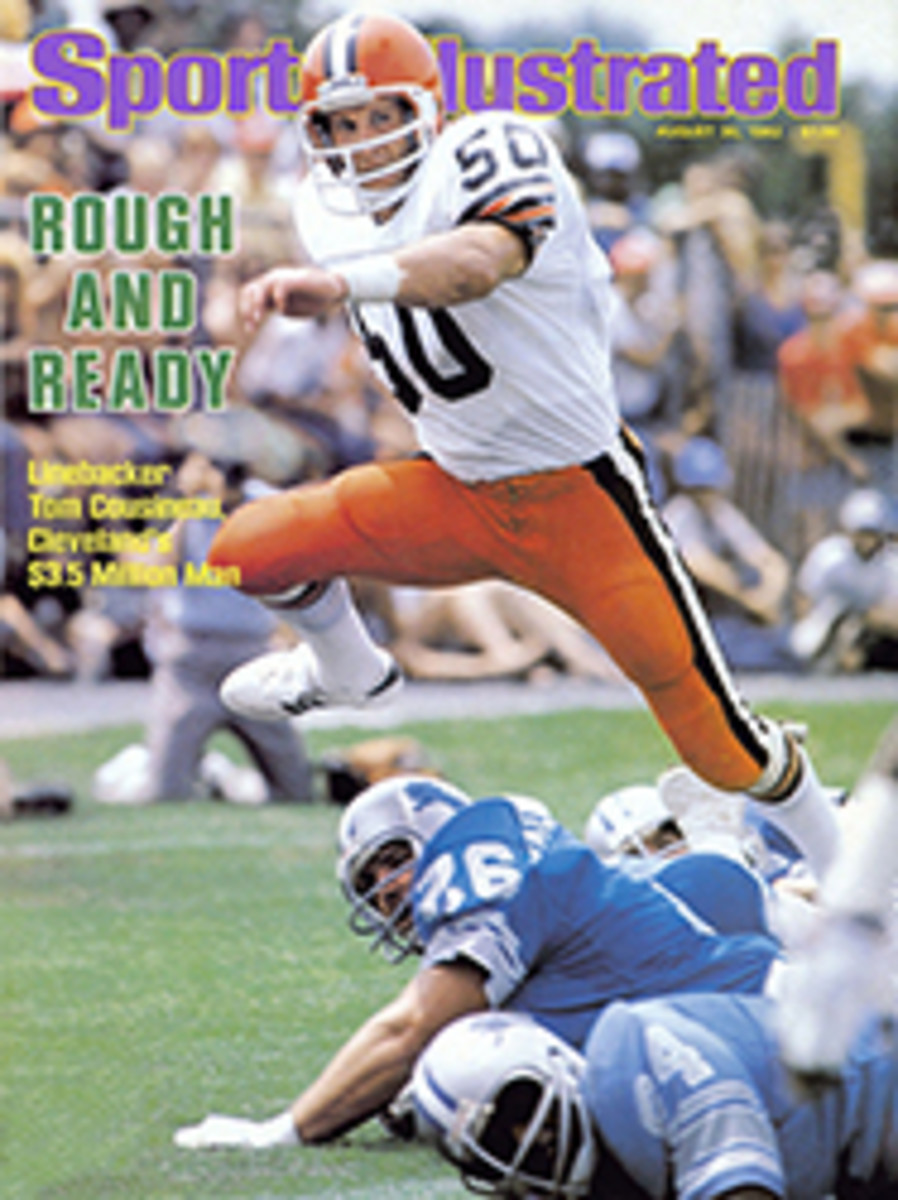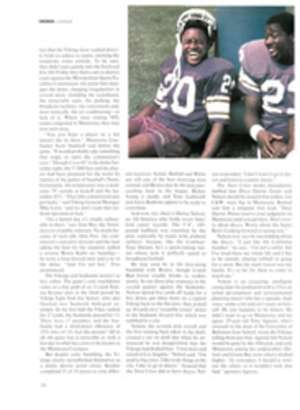
Three jewels in Juli's crown
And whom do we have here? The U.S. Women's Amateur golf champion, 1980. And again in 1981. And now—ta dah!—we give you 1982. Juli Inkster is only 22 years old and looks as if she could keep rolling along forever, relentlessly, year after year after year—or at least until she hits senior play, in which contestants must admit to being 50. There's just nobody around who can beat her. This is now official news, since the latest batch of contenders made a vigorous run at her last week in Colorado, and still Inkster emerged on Sunday evening with the title. Going in, she was only the ninth player ever to win two consecutive championships in the 81 years of this event. Coming out, she was the fifth ever and the first since Virginia Van Wie in 1934 to win the title three years in a row.
What's more impressive, or at least considerably more fun, is that Inkster beat the challengers in a dozen different ways. She destroyed them with her long game, featuring high, arcing drives powered by what she calls her Free Arm Swing (more on the amazing No Hips Free Arm in just a moment). She also demoralized them with her short game, crisp approaches and a variety of calculated curlicue putts. She beat five challengers at match play before Sunday's 36-hole final, and not a slouch among them. Indeed, they included such notables as 1973 U.S. and 1974 British Amateur champion Carol Semple, her Curtis Cup teammate, who fell 3 and 1, and former U.S. Girls', PGA and Orange Bowl Junior champ—and tournament medalist—Penny Hammel, who was a 2-and-1 victim in the quarterfinals. And on Sunday, still relentless, she delivered a 4-and-3 trouncing to Cathy Hanlon of Palos Verdes Estates, Calif., another Curtis Cupper who was a surprise finalist.
All of this action came in a week of mostly pleasant days on the side of Cheyenne Mountain at around 5,200 feet or so, with Colorado Springs lying like a toy city far below. The setting was the Broadmoor South Course, and its owners are fond of noting that the "rugged beauty was not disrupted when each hole was fitted naturally into the terrain." Oh. What that really means is a layout of strangely narrow fairways that wander between thickets of impenetrable junipers, piñons, thistles, scrub oak, laurel and rocky outcroppings that look suspiciously like mountain lion lairs. Not only that, but the whole place is also tilted, surely more than most hillside courses, so golf balls that should land and just lie there quietly on the greens suddenly start inching off toward town. It's a sort of lushly forested fantasy world.
And somewhere high in the hills above the course—you can't see it because it's hidden so deeply in the pines—is the town zoo. Also close by, possibly just over that ridge, are the Broadmoor skeet ranges. Together, they serve to create wonderful effects: Hunched over a crucial putt, a golfer might suddenly hear an elephant snort. At other times, the dull thump of gunfire echoes hollowly back in the hills, as if the Indians had trapped somebody in a box canyon.
This isn't smart-alecky criticism. No sir. The word for all of this is refreshing. After all, you don't get such classy distractions at Pebble Beach or Augusta National. And especially appropriate about the scene—in fact, the great justice of the week—was that Juli Inkster fully emerged as a refreshing new golf personality.
Inkster, who is nicely rangy and strong at 5'8", has a faintly devilish air about her. There's just the hint of a bend in her nose so that in the right light she takes on a raffish look.
Young Fan: "When I get to be a big girl, I want to be just like' you, Juli."
Inkster: "Oh, really? May I make a suggestion? Take up tennis."
Inkster approaches practice the same way, listening to an imaginary announcer's silky voice murmuring inside her head: "And now, ladies and gentlemen, Juli Inkster steps up to face the most crucial, vital, supremely important putt of her entire career. Sixty-five feet from the cup on this tough, tricky green, fans, and the U.S. Amateur Championship rides on it. The gallery falls silent. And now...she drills it!" Well. Most of the time. Occasionally, she says, the fantasy announcer will growl, "Awwwww."
And between broadcasts—"I mean, you can't play that game all the time"—she practices with a Sony Walkman II draped over her ears. "You oughta do this sometime," she says. "Try chipping to a tape of either REO Speedwagon or Huey Lewis and the News. It does wonders for your game."
This sort of antic imagination began taking shape at Santa Cruz, Calif. in the 1960s and '70s, when the Simpsons—Mom, Dad and Juli's older brothers, Danny and Mike—lived just off the 14th hole at Pasatiempo Golf Club. In 1976, the dashing new pro at the club was one Brian Inkster, who has streaky blond hair, green eyes and a fluid swing.
"I began taking lessons from him when I was 16," Juli says. "I was also working as the cart girl at the club. That is, Brian would bark 'Get a cart up here!' and I'd have to jump. The secret reason I married him when I was 20 was so I could get a raise and a better job in the office."
What she also got was this huge, flowing game, peculiarly hers, accented by an extraordinary swing. "I taught her a method I call the Leslie King," says Brian.
Oh, the old Leslie...the who?
"Leslie King is 73 now," Brian says. "He teaches in London. He's holed up in what used to be squash courts in a beat-up apartment building not far from Harrods. There's no golf course, nothing. Just nets. He makes you hit into nets so you can concentrate on your swing and not worry about where the ball's going. He's the master."
"And it's all in the arms. See?" says Juli. "It's tricky to learn. See, in the U.S. we overstress the lower body. We insist that you have to generate power with the swing of your hips. But not The Old Leslie King. With him, it's all arms first, and then...." She pauses. "Look at Tom Watson!" she barks. Everybody jumps, as if Watson has just walked into the room. "I mean, watch him swing. You can't tell me that he doesn't do it all with his arms."
The Free Arm Swing has carried Juli Inkster to some pretty nifty triumphs. In her debut in national competition she was second-low amateur in the 1978 U.S. Women's Open; she was 1981 California Amateur champion; a college all-star at San Jose State; and a member of the 1980 U.S. Women's World Amateur Team and the victorious 1982 Curtis Cup team, which defeated Great Britain-Ireland 14½-3½ three weeks ago at the Denver Country Club. Inkster won all four of her matches there, including each of her two singles matches by the staggering score of 7 and 6.
And at Colorado Springs she just kept rolling on, wearing that rakehell look from time to time. Indeed, when the divots of the last day had settled, Inkster had upped her astonishing match-play record to 20-2 in five consecutive Women's Amateurs and won 18 straight matches.
In the morning, with the dew still roughly up to their shinbones, the ragged little gallery assembled around the 1st tee. Everybody, of course, faced the golfers. But if they had looked around just then, toward the mountain, they would have seen two deer. They looked like Mom and Pop deer, standing in the back row as quietly as everyone else. After Hanlon and Inkster had played away, the critters shrugged, if that's possible for deer, and strolled off in another direction, having seen enough to satisfy their curiosity.
They missed all the good stuff. Especially the alltime crusher, delivered in the afternoon's 18. The two women had played more or less evenly—no great edge that the other couldn't overcome—until the 30th hole of the match. It's a 490-yard, par-5 monster with a canyon running diagonally through the middle, followed by a giant-slalom slope dropping toward the valley floor. Hanlon hit a fine, crisp drive off the tee. So did Inkster. Then, after walking a few steps to peer down the steep slope, Inkster went back to her ball in the fairway and lofted it somewhere into the sun. It came down on the green far below, plunk, and rolled smack up to the pin. It was, to be historically precise, a 239-yard four-iron shot, a shot they'll talk about at the Broadmoor for years to come, not to mention the eagle it led to.
When the end came, Inkster had made 10 birdies and an eagle in 33 holes, which is pretty impressive scoring by any standard. Thus endeth one of the country's outstanding amateur careers. Oh, there'll be a tournament or two more, but come January, Inkster plans to compete in the LPGA qualifying school, with every prospect thereafter of knocking some socks off the big ladies. Her husband, now the pro at the Los Altos (Calif.) Golf and Country Club, will help where he can; in a way, he says, "Juli's career has become my career."
With that, everybody trooped down the mountainside, leaving it as it was before. A place—this is serious, now—where the deer and the antelope play.
PHOTO
PHOTO
Juli's caddie and mentor is her golf-pro husband, Brian.

